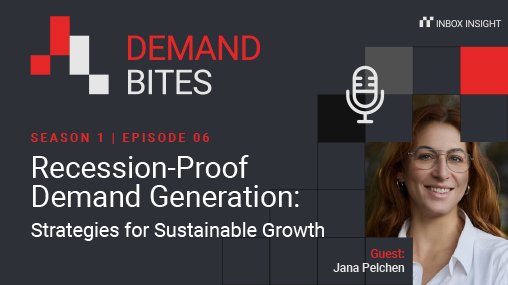This week on Demand Bites, Ross sits down with demand generation expert Jana Pelchen to explore actionable strategies for navigating economic downturns, optimising marketing efficiency, and aligning sales and marketing for maximum impact.
Jana shares key insights on avoiding panic-driven marketing decisions, leveraging first-party data for better targeting, and optimising cost efficiency in demand generation. Whether you’re looking to recession-proof your marketing strategy, improve CAC payback, or strengthen cross-functional collaboration, this episode is packed with valuable takeaways.
🎧 Listen to this episode now:
Or tune in on Apple Podcasts.
Demand Bites is the podcast where B2B demand generation leaders share strategies you can use to identify, educate, and convert your ideal customers.
Enjoyed the episode? Don’t forget to rate, review, and subscribe to Demand Bites on your favorite podcast platform!
Key moments:
[01:19] Jana’s journey into demand generation
[02:42] Common mistakes businesses make in a downturn
[04:17] How chasing cheaper leads can backfire
[05:57] Rethinking marketing measurement in a crisis
[06:52] Actionable tips for recession-proofing marketing plans
[07:35] The power of organic channels and thought leadership
[08:52] How AI is changing the B2B buyer journey
[09:52] Aligning sales and marketing: Five key pillars
[11:00] The role of data, KPIs, and technology in driving alignment
🎙️ Tune in to this episode on your favorite platform: Apple Podcasts | Spotify.
Useful links:
Jana: If you ask me right now, which KPI I would pick, I would go for CAC Payback, I think. You know, like, the measurement of when we know how much we earn compared to the cost of a customer, we can get it back. And for me, it has some clear pros. So it’s a, it’s a clear and simple benchmark. I think people can understand it very easily.
It also has the cashflow focus, which we definitely need also on the demand gen side. And it also evaluates the efficiency when it comes to demand generation initiatives. So that’s definitely like the pro side of it.
Intro: Welcome to Demand Bites, the podcast where B2B demand generation leaders find the strategies they need to grow.
I’m your host, Ross Howard, Director of Insights at Inbox Insight. And in just 15 minutes, my guests and I will uncover what’s broken in the B2B buyer journey and provide real-world strategies you can put to work right away. So whether you’re looking for an innovative demand generation technique or expert advice on accelerating sales, this podcast gives you the tools you need to succeed. Ready to identify, educate, and convert your ideal customer profile? Or at least learn how other people are doing it? Let’s dive in.
Ross: Jana Pelchen, welcome to Demand Bites. Thank you so much for coming on the show.
Jana: Hi Ross, thanks a lot for the invitation. I’m super happy to be here with you.
Ross: Same, I’m really excited for this conversation.
So, thanks so much for joining us. You have a ton of experience in demand generation. What is it that attracts you to marketing?
Jana: Back in the days when I came to Berlin to the startup scene, I started marketing in the field of CRM marketing. And in the beginning, like what I really loved about is like finding or identifying the right approach with the first party data you are able to gather.
And, just like more and more, like when I made my career also in the area of demand generation, that this was still also something where I had to think back, like also now talking about more complex buyer journeys in the field of B2B marketing, we’re talking about various of different buying personas and also higher basket value.
First party data is definitely a first party and part and customer data is definitely still key for success. And this makes it so interesting for me and why I’m still in this area of marketing, especially now in B2B marketing.
Ross: In terms of one of the topic areas that’s been something our customers and the audience have been talking to us about, working with a client who’s maybe facing economic hard times or facing a downturn, what are some common mistakes for growth that companies make in a tough macro?
Jana: It’s interesting. I mean right now we are in this kind of like downturn, we’re talking about financial economics at the moment.
So we can see that on the early stage time, like for younger, younger companies, but also for more mature companies. So one mistake definitely is get into panic mode. Yes. Okay. Indeed. So right now we have to be cost conscious when it comes to marketing initiatives. All companies need to reduce their costs, but I also, I always saw like always, but I often see for companies that they forgot about their fundamentals.
They go to marketing, they losing the marketing brain, let’s say, and they do this kind of ad hoc things, which doesn’t make any sense and which does not fit or match the overall strategy.
There was one example of a company I supported. Their target audience were wealthy private people, and the entrance price for their product was 100,000 euros. So like we’re talking about quite monthly.
And then because of the crisis at the moment, for the first time they were forced to become proactive in their channel and with their growth strategy. That means like right now they were like, okay, pipeline is empty. We need to generate pipeline. How can we do that?
And then they were looking into native ads. And they were like super positively surprised because with native ads, they were able to generate very, very many leads for very little price. Why I’m telling you this right now: this is definitely one example of panic mode. Cheap is not always good.
The leads were cheap, but the pipeline in the end was not working out because the leads did not convert. More than intuitive at this stage.
Ross: I think that’s a brilliant point. I think you can see people trying to chase cheaper lead acquisition to the point where it decays, either the engagement of that lead or the targeting, like the quality can either be how warm are they and how interested are they, or what fit are they for your company, like how much do they match your ideal customer profile?
And if you degrade either one of those in your efforts for cost saving, it just hurts you in the end, but you don’t find out for like six months. And so that test and learn process so that you don’t panic is so important.
That’s great advice.
Jana: Another one I would say just like also the don’t panic is, often companies stick to these old measurements. Because like post crisis has always worked that we generate pipeline with this measurement X, Y, Z. But of course, not only us as the company, but also our customers are in this kind of crisis or in this kind of circumstances. But it’s also one common mistake I saw that companies stick to the like the evergreen, but now, especially in times of crisis is definitely one advice that I think about like, okay, what could be the change in terms of needs for the customers? Do we have to work on a new messaging? Do we have to define new value proposition in order to show the customers that they, that we also as a company understand their change in needs?
Because I once read the sentence is that, in crisis companies either buy the cheapest product or the product they have the most trust in it. And I think like when companies can prove that they understand like also the changing the needs of the changing needs of customers, I think they’re doing very well in working on this kind of trust.
Ross: That’s really cool. Can you share any actionable tips on how a business can recession proof their marketing planning?
Jana: Yeah, of course. So there is some advice I can give companies in times like this. So first of all, it’s cost efficiency. Know your analytics, especially in times like that. It’s crucial to understand what your analytics are? That means like ensure tracking monetization. And then if you have the analytics, optimize everything towards sustainability.
And I’m talking about KPIs now, like cost per lead, customer acquisition cost, return on investment – super important at the moment. So all companies are asking us marketers about, okay, what’s the ROI for campaign X, Y, Z?
And then also something when you’re, for example, in the SaaS industry subscription model, then CAC payback. So how long does it take in months, weeks, quarters, etc., until you earn the money that you spend for the customer?
Ross: That’s great.
Jana: Then this was like one advice that the other one is of course, I mean, it’s a no brainer leveraging everything towards organic and low cost channels.
I’ve been talking about right now about SEO and content. Content definitely leveraged by AI, so that’s super easy. And then we also discussed that it’s about thought leadership and organic social. I think at the moment we can see a lot and also just, especially in the B2B journey, the buyer and seller relationship.
Now with the AI, it changed drastically. So the buyer is more informed than ever. And that means like for us, the sellers, we have to do a lot in terms of though leadership that we are still perceived as an expert. So this is definitely something companies should invest in.
Ross: That’s so true. We recently ran a tech buyer research study and within there, 46% of the target audience said that they would trust ChatGPT or an LLM during the their research cycle on a complex IT purchase, which was way higher than I thought for that audience.
It was all Manager + IT decision makers or Finance decision makers specific to that you know, more complex sales cycle. So you would expect them to be digging into the details, but actually in the initial phase of research, 50% go straight into ChatGPT looking for the background and that’s going to erode informational search.
It’s going to erode trust or access for brands to control how their brand is presented and like, to your point, the buyer’s just up to speed much faster, but potentially not in the way that you want with your messaging.
So making sure that you’ve been proactive in seeding the market and creating demand with your version of, you know, the value that you want to produce and the content messaging that you want to get out there to customers is more important than ever to be proactive because you’re not in control of what people read about you as much at least half the time.
In terms of the sales and marketing relationship, what are some tips that you’ve got in terms of how to get sales and marketing to work together seamlessly?
Jana: This is definitely one of my favorite topics because also my experience has proved me that marketing and sales are talking different kinds of languages.
Also, they are also differently incentivized. I think this is definitely also one crucial aspect of why they don’t align.
And tips or advice I can give are in five pillars, let’s say. So first of all, on the strategic component, which is trying to sharpen this overall alignment when it comes to revenue targets. What’s the go to market strategy? We talk about ICP; do we have this common understanding of ICP? And then also to align the campaigns and initiatives that are currently active and running.
Then the second component is definitely the processes or process component, which is to align the funnels. That means, on the one hand side, the lead funnel when you talk about a new customer acquisition, but also the opportunity funnel when we talk about retention business to align it; make it one.
For the marketing side and the sales side, also, to make it transparent. Then, define clear responsibilities and roles, especially when you have lead routing and lead handing over from marketing to sales. This is where the most mistakes or the most risk could happen.
So, with a clear understanding and someone who is really taking care of just this bridge, this is definitely crucial for success.
Then as the third component, of course, KPI and data. Not only is there misalignment in terms of ICP, but I have also had the experience that some teams have other definitions of KPI.
So what is an SQL and when is an sales accepted lead? Bring everyone on the table and make clear what the definition is behind every KPI and then also look on common reporting dashboards, so there’s also increased transparency and make the funnel transparent that the marketing people know what’s going on in the sales, like on the lower funnel and vice versa.
The fourth component would then be the tech stack in terms of alignment. I think this is crucial. This is the heart where everything comes together. That means all the processes have to lie in a CRM. The CRM setup has to be perfect, based on the needs of the team. And also the adoption should be at a level that everybody is able to use the CRM and to see the data in it.
The last component, and to close my monologue: it’s about management. We are not only communicating via the CRM; it’s also crucial to set up a weekly or bi-weekly operational demand gen sales meeting at an operational level so that people can say, which campaigns are running at the moment? The sales team gives the marketing team feedback about lead quality and about interviews they’ve had with customers.” That way, the marketing team is able to adapt campaigns.
And then on a monthly level, there should be a strategic meeting after the entire monthly data has been gathered about the marketing and sales team, where they discuss the overall strategy.
Ross: Fantastic. There you go. Five steps to perfect demand gen. I love it.
You mentioned KPIs there and we’ve spoken about it a lot. What are some examples of the best metrics that you think a B2B marketer should prioritize?
Jana: So first of all, what I think definitely B2B marketers should be responsible is also revenue. I think this is at the moment, like, one of the discussion topics when we’re talking demand generation, revenue marketing, that also marketing should become responsible when it comes to revenue, especially also now.
And I 100% agree with that. So marketers should not be incentivized for MQLs. They should also incentivize down the funnel. And if you ask me right now, which KPI I would pick, I would go for CAC payback I think. You know the measurement when we know how much we earn to the cost of a customer, we can get it back.
And, for me, it has some, some clear pros, so it’s like, it’s a clear and simple benchmark. I think people can understand it very easily. It also has the cashflow focus, what we definitely need also on the demand gen side. And it also evaluates the efficiency when it comes to demand generation initiatives.
So that’s definitely like the pro side of it. Of course. Yeah. It’s like. I’m not sure like they’re definitely they’re also not not only pro sites. So one thing what I think is definitely what you have to discuss, so it works quite well when you’re in a subscription model business or in a SaaS business. But this is definitely something what you have to elaborate a little bit more if you’re in the distributed business or ecom or something like that.
So this is something which is not the best, but definitely I think it goes in the right direction yes.
Ross: I totally agree.
Ross: In terms of some misconceptions that B2B marketers have about demand gen, what’s the top misconception that you would want to correct if you could make people see the lie?
Jana: Okay. Definitely number one, demand gen is not lead gen. That’s okay. Yeah. I can see you nodding. It’s definitely something where also like C-Level or sales, they, they don’t understand. We are not generating leads. That lead generation is part of demand generation. Demand generation is much, much more like it also effective demand generation includes, brand building, awareness, upselling cross-selling, lead nurturing, and that makes it so exciting.
Ross: Thank you so much for this call Jana, I’ve learned loads already.
Where can people find out more about you and your new consultancy?
Jana: So you can learn from COM Works either on my LinkedIn, so follow Jana Pelchen on LinkedIn. There you can find COM Works or you just visit com-wrks.com. And then you find everything.
Ross: Fantastic. Thanks so much.
Jana: Welcome. Thank you.
Outro: And that wraps up today’s episode of Demand Bites.
Thanks for listening. I hope the insight provided today are able to help you power up your own demand generation efforts. If you’ve enjoyed what you’ve heard, make sure to hit subscribe so you’re always up to date with the latest strategies. If you’re looking for more insight, stay connected with Inbox Insight on LinkedIn and join a network of marketing leaders driving the future of demand gen.
Stay ahead with expert demand gen strategies
Subscribe now to get exclusive access to episodes packed with real-world strategies to drive ROI and build a high-performing pipeline:






